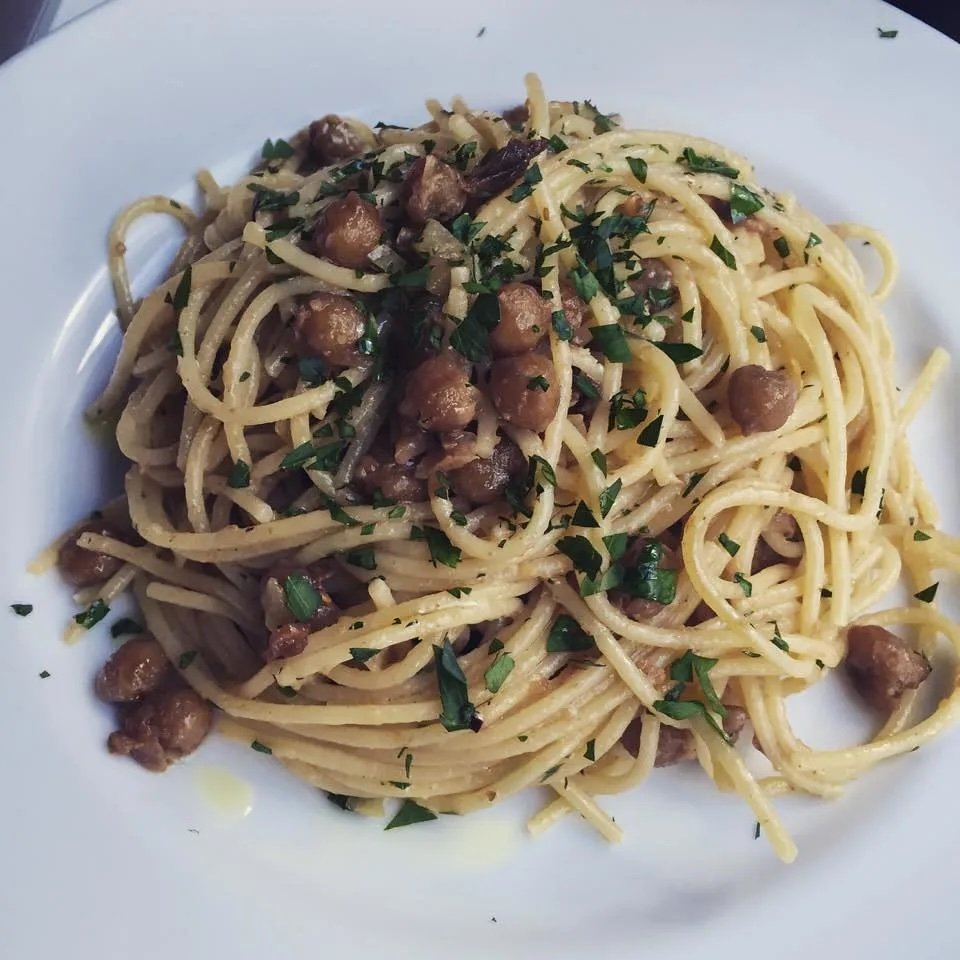Spaghetti with Crispy Chickpeas and Preserved Lemon
Tom Colicchio’s always like “you didn’t develop any flavor” on Top Chef and most people are probably like “what’s he talking about?” My quick answer is: “He’s talking about making things brown.”
Generally speaking, when you’re cooking something, you want it to turn brown (or, to use a prettier word, you want it to “caramelize.”) What that really comes down to is taking things further than you might otherwise feel comfortable. The hard part is if you take them too far, there’s no going back. So you’ve gotta get in there, hover over the pan, but don’t hover too much–if you stare, you’ll be tempted to stir, and that stops the browning. It’s a delicate dance, developing flavor, but if you do it the right way you can create a dish that’s way more dynamic than it has any right to be–like this dish of spaghetti with crispy chickpeas and preserved lemon.
Riffing on a recipe from the Franny’s cookbook, I drained a can of chickpeas and patted them dry with paper towels. Then I heated about 1/4 to 1/2 cup of olive oil in a large skillet while bringing a big pot of water to a boil for the pasta. When the olive oil was good and hot, I added the chickpeas:

A loud sizzle will happen: don’t be scared. Here’s where you should leave them alone for a few minutes so they turn brown. If you stir, they’ll break up and you’ll have chickpea mush. After about 4 minutes, they had some color:

At this moment, I added about 4 cloves of sliced garlic and an anchovy which I stirred into the mix:

Here’s where things got really deep and dark and exciting (Tom Colicchio would be proud)–I cooked the mix until the garlic was just golden brown and the chickpeas almost chestnut-colored:

It’s at this moment that you want to stop the cooking so you add about a half a ladleful of salted pasta water (don’t be shy with the salt in the water). There’ll be another loud sizzle! (Oil and water, as you know.) But then you stir the water in, let it evaporate a bit, and set the chickpea pan aside.

This is a good time to drop in your spaghetti. Let it go for about a minute or two less than the package says it should; meanwhile, take a preserved lemon (I bought mine from the Cheese Store of Silverlake) and cut off the rind and chop it.

To finish, turn the heat back on the chickpea pan and when the spaghetti is super al dente, lift it out of the water with tongs and stir into the chickpea mixture, adding some pasta cooking water if the pan is dry. Stir all around with tongs on medium heat until the liquid is absorbed and everything is coated; then add the preserved lemon, stir that in, and finally lots of chopped parsley.

It’s hard to convey how flavorful this was, but maybe it’s not hard to convey when you see how brown everything got in the pictures. See, I’m not lying. That’s the secret to developing flavor–brown food. You could win Top Chef on the premise alone!
So get yourself a can of chickpeas and some spaghetti and get practicing. If you can make those two ingredients taste this good, there’s no telling what you might do. Welcome to Brown Town.

